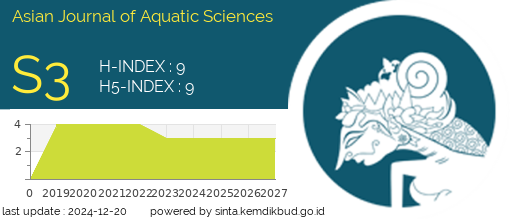UTILIZATION OF MANTIS SHRIMP RESOURCES (Harpiosquilla raphidea) IN LABUHANBATU WATERS, NORTH SUMATRA PROVINCE
DOI:
https://doi.org/10.31258/ajoas.8.277-284Keywords:
Mantis Shrimp, Bioeconomic, MSY, MEY, OAAbstract
Mantis shrimp (Harpiosquilla raphidea) can be found in the waters of Labuhanbatu, North Sumatra Province. The significant economic value and fishing effort of this shrimp species are believed to affect the decline in population numbers in the Labuhanbatu aquatic ecosystem, which has the potential to threaten the sustainability of its natural habitat. This study aimed to analyze the resource utilization of mantis shrimp in Labuhanbatu waters. The research methodology used was secondary data analysis. The research was conducted from November 2024 to April 2025, specifically in the waters of Labuhanbatu, North Sumatra Province. The dataset analyzed includes time series data from 2017 to 2024, including information on mantis shrimp catches and the number of fishing trips obtained from the Labuhanbatu Regency Marine and Fisheries Service. Data analysis was carried out using the Gordon-Schaefer bioeconomic model, along with calculations of utilization rates and effort rates. The results of the resource utilization analysis showed that mantis shrimp in Labuhanbatu have been overexploited. In catch rate optimization and cost reduction, scenarios that produce maximum economic yield (MEY) show higher profitability than scenarios based on maximum sustainable yield (MSY). This highlights the unsustainability of open-access mantis shrimp fishing practices in Labuhanbatu waters and the potential for mantis shrimp resource depletion. Furthermore, the utilization rate estimated at 93% indicates overexploitation, where the exploitation rate exceeds the MSY threshold. In addition, the effort rate reached 91%, indicating that the production capacity is almost at the maximum limit.
Downloads
References
1. Dimenta, R.H., Machrizal, R., & Khairul, K. Information Reproductive Morphology and Sex Ratio of Mantis Shrimp Cloridopsis scorpio (Latreile, 1828) in Belawan’s Aquatic Ecosystems Mangrove. J Pembelajaran dan Biologi Nukleus, 2019; 5(2): 24-33.
2. Sukarni, S., Rina, R., Samsudin, A., & Purna, Y. Harpiosquilla raphidea, Udang Belalang Komoditas Unggulan dari Provinsi Jambi. Jurnal Penyuluhan Perikanan dan Kelautan, 2018;12(3):174-188.
3. Hasibuan, A.A.D., & Dimenta, R.H. Aspek Reproduksi Udang Mantis Harpiosquilla raphidea di Ekosistem Mangrove Kabupaten Labuhanbatu, Sumatera Utara. Jurnal Penelitian Pendidikan Biologi dan Biologi, 2022; 5(1): 24-34.
4. Wardiatno, Y., & Mashar, A. Biological Information on the Mantis Shrimp, Harpiosquilla raphidea (Fabricius 1798) (Stomatopoda , Crustacea) in Indonesia with a Highlight. Journal of Tropical Biology and Conservation, 2010; 7:65-73.
5. Murni, S., & Dimenta, R.H. Bioekologi Udang Swallow (Penaeus merguiensis). BIOEDUSAINS: Jurnal Pendidikan Biologi dan Sains, 2021; 4(1):99-111.
6. Astuti, R.I., & Ariestyani, F. Potensi dan Prospek Ekonomis Udang Mantis di Indonesia. Media Akuakultur, 2013; 8(1): 39-44.
7. Situmeang, N.S., Purnama, D., & Hartono, D. Identifikasi Spesies Udang Mantis (Stomatopoda) di Perairan Kota Bengkulu. Jurnal Enggano, 2017; 2(2):239-248.
8. Mashar, A., & Wardiatno, Y. Distribusi Spasial Udang Mantis Harpiosquilla raphidea dan Oratosquillina gravieri di Kuala Tungkal, Kabupaten Tanjung Jabung Barat, Provinsi Jambi. Jumal Pertanian-UMMI, 2011;1(1):41-46.
9. Dimenta, R.H., Machrizal, R., Khairul, K., Hasibuan, R., Manurung, A.Q., & Ihsan, M. Biologi Reproduksi Udang Mantis Cloridopsis scorpio di Ekosistem Mangrove Belawan, Sumatera Utara. Depik Jurnal Ilmu-Ilmu Perairan, Pesisir dan Perikanan, 2020; 9(2): 227-234.
10. Suman, A., Lestari, P., & Damora, A. Pengelolaan Udang Mantis (Harpiosquilla raphidea) di Perairan Tanjung Jabung Barat dan sekitarnya, Jambi. Jurnal Kebijakan Perikanan Indonesia, 2021;13(1):43-58.
11. Wang, J., Jiang, Y., Zang, J., & Chen, X.D.K. Catch per unit effort (CPUE) standardization of Argentine shortfin squid (Illex argentinus) in the Southwest Atlantic Ocean using a habitat-based model. International Journal of Remote Sensing, 2020; 41(24):9309-9327.
12. Gordon, H.S. The Economic Theory of a Common-Property Resource : The Fishery. The Journal of Political Economy, 1954; 62(2):124-142.
13. Schaefer, M.B. Some Considerations of Population Dynamics and Economics in Relation to the Management of the Commercial Marine Fisheries 1. Journal of the Fisheries Research Board of Canada, 2002.
14. Kristiana, H., Malik, J., & Anwar, N. Pendugaan Status Sumberdaya Perikanan Skala Kecil di Kota Semarang. Jurnal Pengelolaan Perikanan Tropis, 2021; 5(1):51-58.
15. Listiani, A., Wijayanto, D., & Jayant, B.B. Analisis CPUE (Catch per Unit Effort) dan Tingkat Pemanfaatan Sumberdaya Perikanan Lemuru (Sardinella lemuru) di Perairan Selat Bali. Jurnal Perikanan Tangkap (Juperta), 2017;1(1):1-9.
16. Siregar, I.H.K. Pengembangan Teknologi Penangkapan Ikan yang Bertanggung Jawab di Perairan Kabupaten Labuhanbatu Provinsi Sumatera Utara. Jurnal Perikanan dan Kelautan, 2018; 23(1): 57-68.
17. Wulandari, D.P., Kamal, E., & Yuspardianto, Y. Studi Pendugaan Stok Udang Mantis (Harpiosquilla raphidea) di Desa Parit III Kecamatan Tungkal Ilir Kabupaten Tanjung Jabung Barat. Ejournal Bung Hatta, 2019;15(2):1-13.
18. Saputri, D.M., Yunita, L.L., Yurleni, Y., Alwi, Y., Endang, E.R., & Ramadan, F. Analisa Maximum Sustainable Yield (MSY) Tangkapan Udang Mantis (Harpiosquilla raphidea) di Perairan Pantai Timur Jambi. Jurnal Ruaya, 2024;12(2):199-207.
19. Dafiq, A.H., Anna, Z., Rizal, A., & Suryana, A.A.H. Analisis Bioekonomi Sumber Daya Ikan Kakap Merah (Lutjanus malabaricus) di Perairan Kabupaten Indramayu Jawa Barat. Jurnal Perikanan dan Kelautan, 2019; 10(1): 8-19.
20. Siregar, I.H.K., Amin, B., Efizon, D., & Warningsih T. Sustainable Utilization of Hilsa Fish (Tenualosa ilisha) Resources in Labuhanbatu waters, North Sumatra Province, Indonesia: A bioeconomic analysis. AACL Bioflux, 2024; 17(2): 811-821.
21. Pascoe, S., Vieira, S., & Thebaud, O. Allocating Repairs and Maintenance Costs to Fixed or Variable Costs in Fisheries Bioeconomic Models. Applied Economics Letters, 2014; 22(2): 127-131.
22. Timmermann, K., Dinesen, G.E., Markager, S., et al. Development and Use of a Bioeconomic Model for Management of Mussel Fisheries under Different Nutrient Regimes in the Temperate Estuary of the Limfjord, Denmark. Ecology and Society, 2014; 19(1): 14.
23. Yusrizal, Y., Wiyono, E.S., Simbolon, D., & Solihin, I. Estimation of the Utilization Rate of Fish Resources in the Northern Coast of Java, Indonesia. AACL Bioflux, 2018; 11(6): 1807-1824.
24. Arief, H., Yanti, C.W., Metalisa, R., & Pradini, U.R. Potential and Utilization Level of Giant Tiger Prawn (Penaeus monodon) in Rokan Hilir Regency, Riau Province. AACL Bioflux, 2023; 16(6): 2973-2982.
25. Desiani, R., Susiana, S., & Lestari, F. Utilization Rate of Yellow and Blueback Fusilier (Caesio teres) at Mapur Waters Fish Landing in Kelong Village, Bintan Coastal, Bintan Regency, Indonesia. Jurnal Akuakultur, Pesisir dan Pulau-Pulau Kecil, 2019; 3(2):49-55.
26. Sari, R.P., & Akbarsyah, N. Produktivitas Alat Tangkap Pancing Ulur di Provinsi Nusa Tenggara Barat. Aurelia Journal, 2020; 1(2):53-60
Downloads
Published
Issue
Section
License
Copyright (c) 2025 Irham Huspa Khasahatan Siregar (Author)

This work is licensed under a Creative Commons Attribution 4.0 International License.







